

Online Guide to Theory of Constraints - A Must See. Preface. How To Use This Site It struck me one day, as I was searching, that even in the largest technical bookshops in some of the largest industrialized cities in the world, such as Tokyo or Singapore, we are hard-pressed to find an aisle for operations.
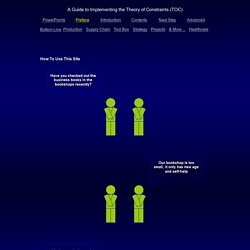
Sure, there is no shortage of advice on strategy, but there is a very real dearth on the tactics that are needed to put the strategy into place. And, honestly, if we don’t know the tactics, then how on earth can we really know the strategy that goes with the tactics? Strategy and tactics are interrelated. I find this very strange, there is no shortage of advice on the thinking/talking part of business, but there is a very apparent shortage on the people and doing part of business. This website is about the Theory of Constraints – how to substantially improve an organization, any organization, by moving a group of people towards a common shared goal.
All the topics and sub-topics are listed and can be accessed directly from the site map. Introduction. Let’s Start By Stopping For A Moment Slow down, block out the rest of the world for a moment, and take the time to consider the following.
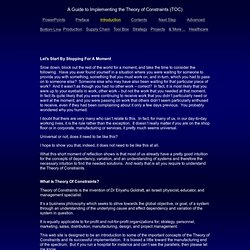
Have you ever found yourself in a situation where you were waiting for someone to provide you with something, something that you must work on, and in-turn, which you had to pass on to someone else? Someone else who may have also been waiting for that particular piece of work? And it wasn’t as though you had no other work – correct? In fact, it is most likely that you were up to your eyeballs in work, other work – but not the work that you needed at that moment. I doubt that there are very many who can’t relate to this. Universal or not, does it need to be like this? I hope to show you that, indeed, it does not need to be like this at all. Contents. PowerPoints. PowerPoint Presentations There are currently 7 PowerPoint presentations available online to anyone, the remainder are for client use only.
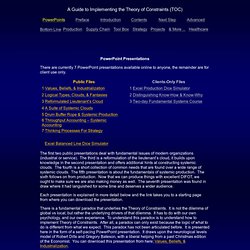
The first two public presentations deal with fundamental issues of modern organizations (industrial or service). Bottom Line. Increasing Profitability Through Increased Productivity Everyone understands the benefit of increasing production; we invest more money, buy more manpower, buy more machinery, and make even more money.
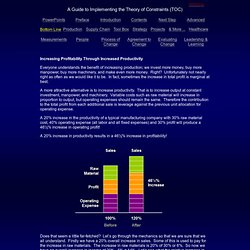
Right? Unfortunately not nearly right as often as we would like it to be. In fact, sometimes the increase in total profit is marginal at best. A more attractive alternative is to increase productivity. A 20% increase in the productivity of a typical manufacturing company with 30% raw material cost, 40% operating expense (all labor and all fixed expenses) and 30% profit will produce a 46½% increase in operating profit! Thinking Process. The Principle of Leverage Theory of Constraints is a systemic/global optimum approach.
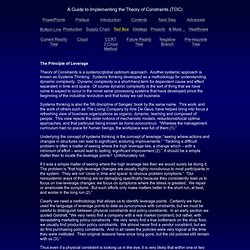
Another systemic approach is known as Systems Thinking. Systems thinking developed as a methodology for understanding dynamic complexity. Dynamic complexity is a short-hand term for dependent cause and effect separated in time and space. Current Reality Tree. Undesirable Effects & Core Problems Is the term firefighting familiar to you?
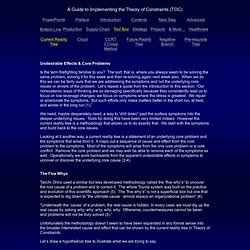
The sort, that is, where you always seem to be solving the same problem, solving it for this week and then re-solving again next week also. Cloud. CCRT 3 Cloud Process. The Communication Current Reality Tree The communication current reality tree is a clever combination of the necessity-based logic of the cloud converted to sufficiency-based logic and then combined with the sufficiency-based logic of the current reality tree to describe the relationship between observed undesirable effects (symptoms) and the underlying core conflict.

It does this by combining the positive aspects of both tools; Future Reality Tree. Future Expectations A future reality tree allows us to map out our future expectations given that we will introduce something new into our reality – the injection that we developed to break our current reality problem or core conflict.
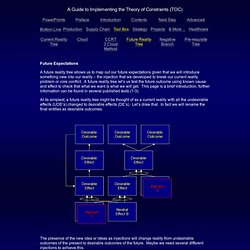
A future reality tree let’s us test the future outcome using known cause and effect to check that what we want is what we will get. This page is a brief introduction, further information can be found in several published texts (1-3). Negative Branch Reservation. We Didn’t Intend That To Happen A negative branch reservation is a modification of the future reality tree that accounts for new negative outcomes that result from our injections.
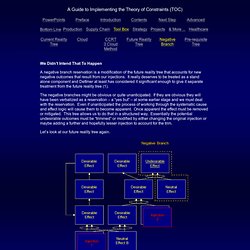
It really deserves to be treated as a stand alone component and Dettmer at least has considered it significant enough to give it separate treatment from the future reality tree (1). The negative branches might be obvious or quite unanticipated. Pre-requisite Tree. Overcoming Obstacles.
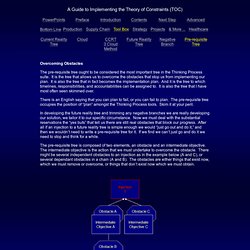
Strategy. Well, Just What Is Strategy? Let’s start by defining strategy. Constraint Management Model. Boyd Meets Goldratt U.S. Air Force Colonel John Boyd inventor of the OODA loop, maneuver warfare, and “father” of both the F15 & F16 fighters (1) had a concept called “building snowmobiles (2).” He used this as a metaphor for analyzing a problem and then synthesizing a solution – something completely new composed of entirely unrelated but pre-existing parts.
Bill Dettmer has done exactly that in constructing a model for lean and rigorous strategy development using concepts and tools from, amongst others; the U.S. Military Strategic Planning Model, and Goldratt’s Thinking Process toolset. Holistic Approach. All Singing From The Same Systemic Song Sheet The Constraint Management Model for Strategy which we examined on the previous page is a superb approach for organization-wide improvement when everyone is already aligned and singing from the same song sheet – or at least is willing to do so. It is without doubt a systemic/global optimum approach. The holistic approach is also a systemic/global optimum approach but one borne out of the experience that not everyone initially wants to, or understands the need to, or even knows how to sing from the same systemic song sheet. Experience suggests that contrary to expectation, a substantial and rapid but localized success in the implementation of any one of the Theory of Constraint logistical or non-logistical applications will not result in a steady and system-wide uptake of that success.
Indeed the opposite may well occur and may eventually result in the winding-back of the initial genuine but localized success. The Holistic Approach Is Not … Strategic Advantage. Is Theory Of Constraints A Strategy? This is more of a personal page than most and it revolves around the question; is Theory of Constraints a strategy? Well, my initial and unsophisticated intuition told me it was. Flexibility. Redundancy And Variety In the section on leadership and learning we introduced some concepts of organizational knowledge creation. There are 5 enabling conditions for organizational knowledge creation; intention, autonomy, fluctuation and creative chaos, redundancy, and requisite variety (1). Paradigms. That “P” Word – Paradigm. SPIN Mafia Offers. Sales Constraints & Mafia Offers We briefly mentioned sales constraints in the supply chain section.
A sales constraint appears to be an external constraint – we can produce more than we can sell. However, we also we learnt in the introduction to the supply chain section that most external constraints actually have internal solutions. In fact they must have internal solutions as there is most often no other way that we can influence the external environment. So, too, with sales constraints. Paradox of Systemism. Introduction.